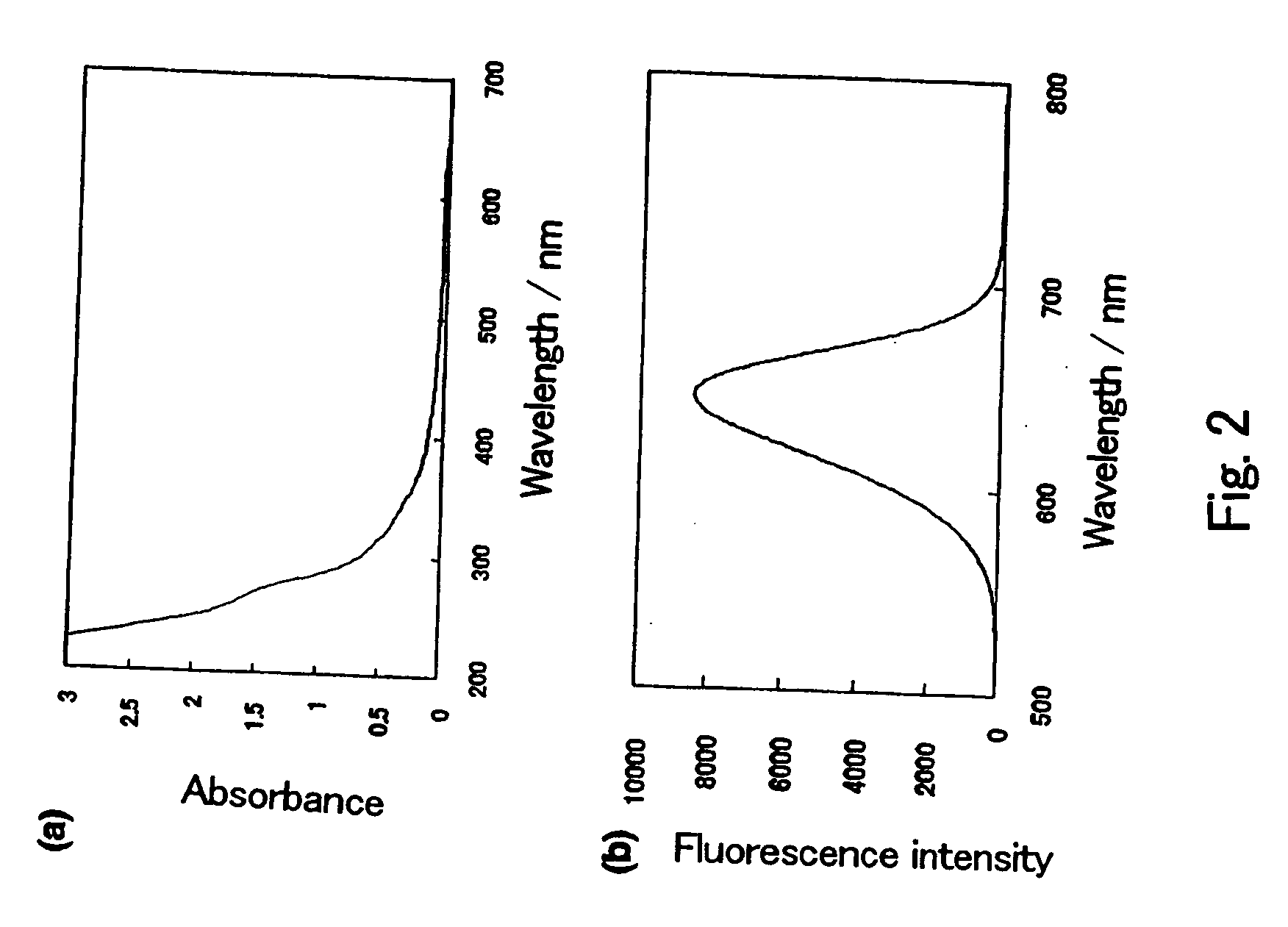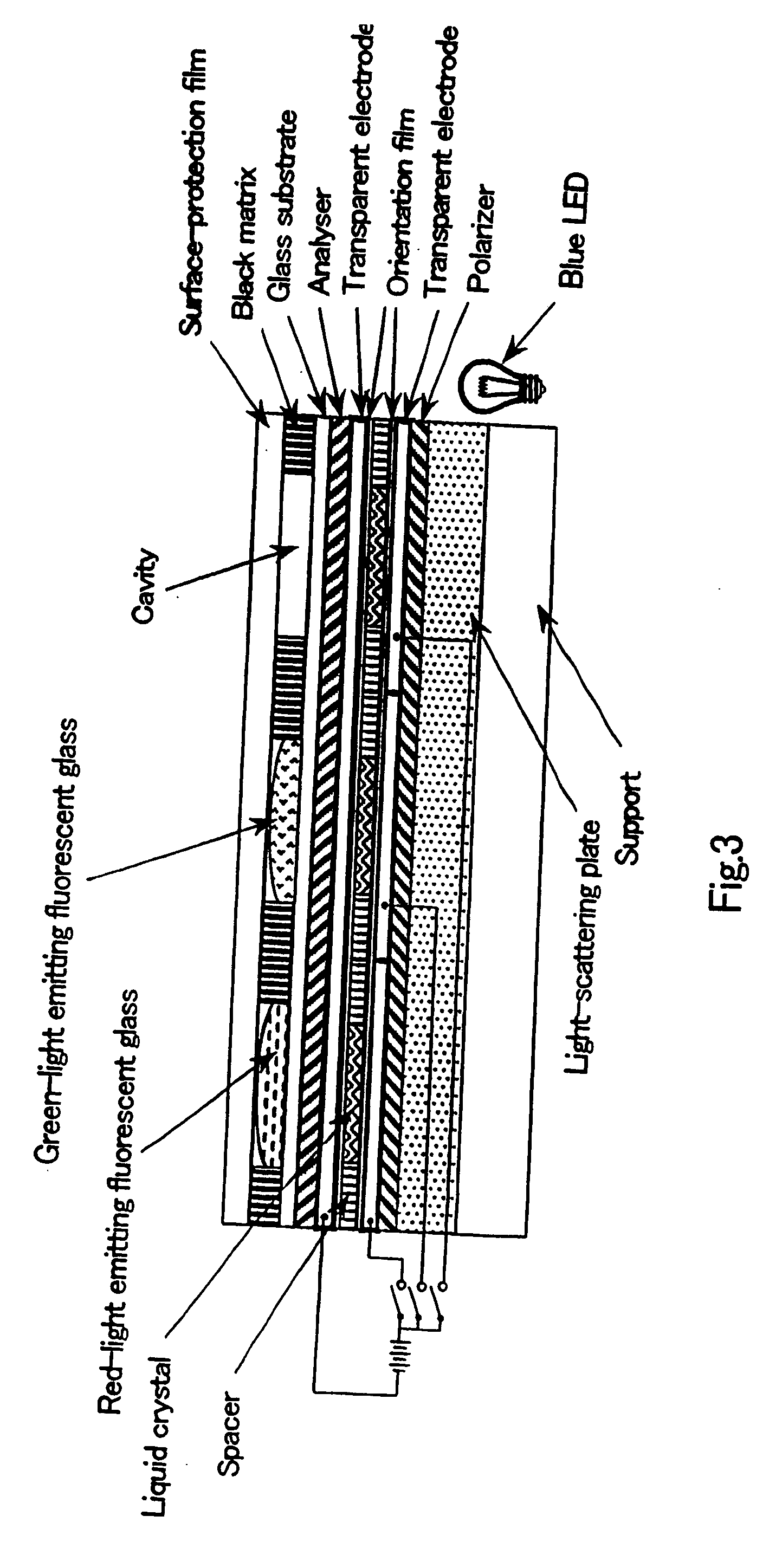Semiconductor ultrafine particles, fluorescent material, and light-emitting device
a technology of semiconductors and ultrafine particles, which is applied in the direction of mercury compounds, lighting and heating apparatuses, instruments, etc., can solve the problems of unstable ultrafine particles produced in ph-reduced solutions, achieving higher fluorescence quantum yield, and poor light resistance, etc., to achieve excellent light resistance, temporal stability, and brightness. good
- Summary
- Abstract
- Description
- Claims
- Application Information
AI Technical Summary
Benefits of technology
Problems solved by technology
Method used
Image
Examples
example 1
[0115] Group II-VI semiconductor cadmium telluride ultrafine particles were produced according to the following process obtained by improving the method described in Gao, et al., Journal of Physical Chemistry, B, vol. 102, p. 8360 (1998).
[0116] More specifically, in a Clean Room (10000 class or less), hydrogen telluride gas was added to an aqueous cadmium perchlorate solution (concentration of 0.013 mol / L) while vigoursly stirring in a round bottom flask charged with an argon gas, and the aqueous cadmium perchlorate solution has apH adjusted to 11.4 and comprises thioglycolic acid (HOOCCH2SH) (TGA) as a surfactant. The resulting mixture was further stirred, yielding a dispersion of cadmium telluride ultrafine particles. The dispersion of ultrafine particles thus obtained emitted red light when irradiated by ultraviolet light. Ultrapure water (produced by a pure water producing machine, Milli-Q synthesis, manufactured by Nippon Millipore Corporation: Specific resistance; 18 MΩ·cm or...
example 2
[0122] 3 g of aminopropyltrimethoxy silane and 28 g of methanol were sufficiently stirred, and 10 ml of the mixture was extracted and put into a petri dish made of a fluororesin with a diameter of 5 cm.
[0123] A small stirring bar was placed in this petri dish, and 2.8 ml of water was then put therein. The mixture was stirred while covering the dish from the top to prevent the entry of dust, and hydrolysis and subsequent dehydration condensation polymerization were allowed to proceed according to reaction formula.
H2N—(CH2)3—Si—(OCH3)3+3H2O→H2N—(CH2)3—Si—(OH)3+3CH3OH
[0124] When the viscosity of the solution reached about 1000 centipoise after about 12 hours passed at a temperature of 23° C. and humidity of 60%, 1.2 ml of the dispersion of cadmium telluride ultrafine particles which emitted the red light of Example 1 (X=1.50, and immediately after production) was put in the solution, and the result was further stirred for 10 minutes, yielding a glass precursor solution. The viscosity ...
example 3
[0127] The glass of Example 2 was heated at 100° C. under an atmosphere of argon for two hours. At this time, the rate of the rise or drop in temperature was set to be 0.5° C. / minute to prevent the formation of cracks in the glass. This heat treatment caused the weight to decrease by about 5%. The fluorescence quantum yield of the ultrafine particles in the glass of Example 2 was retained in the ultrafine particles in the obtained cured glass.
[0128] The hardness of the heat-treated glass was measured with a hardness tester (manufactured by Akashi, Microvickers Hardness Tester MVK-E), and a Vickers hardness of about 50 (490 megapascals in the International System of Units). Since the glass before the heat treatment was too soft and no indentation were formed, the hardness was not able to be measured. As described above, the heat treatment permitted the dehydration condensation reaction to proceed, thereby improving the quality of the glass.
[0129] It was determined that this heat tr...
PUM
| Property | Measurement | Unit |
|---|---|---|
| Temperature | aaaaa | aaaaa |
| Temperature | aaaaa | aaaaa |
| Fraction | aaaaa | aaaaa |
Abstract
Description
Claims
Application Information
 Login to View More
Login to View More - R&D
- Intellectual Property
- Life Sciences
- Materials
- Tech Scout
- Unparalleled Data Quality
- Higher Quality Content
- 60% Fewer Hallucinations
Browse by: Latest US Patents, China's latest patents, Technical Efficacy Thesaurus, Application Domain, Technology Topic, Popular Technical Reports.
© 2025 PatSnap. All rights reserved.Legal|Privacy policy|Modern Slavery Act Transparency Statement|Sitemap|About US| Contact US: help@patsnap.com



